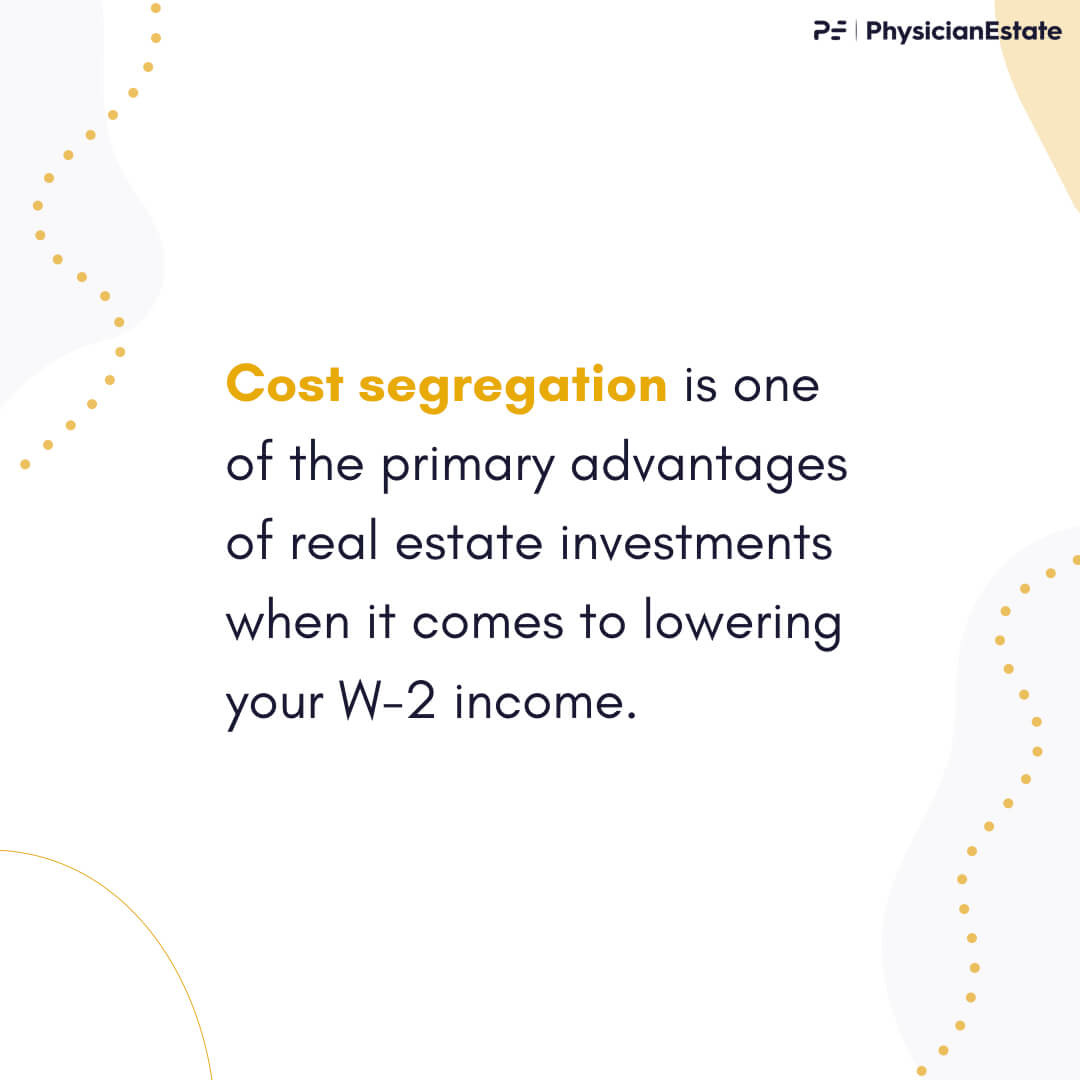How Physicians Can Reduce Tax Bill
Introduction | Cost Segregation and Bonus Depreciation
How Physicians Can Reduce Tax Bill by Using Cost Segregation and Bonus Depreciation. Most physicians fall under the highest income tax slabs. It’s not surprising to find physicians in the 32% or 37% tax brackets.
The good news is that there are some possible strategies doctors can use to lower their W-2 income. And our favorite one is through real estate.
Real estate is known to offer some of the highest tax breaks. We already discussed how physicians could cut their W-2 income through the Real Estate Professional Status in the previous post.
Real Estate Professional Status allows professionals, as well as salaried individuals, to write off their real estate losses from W-2 income.
You have to satisfy two conditions for Real Estate Professional Status:
- Real estate must be your primary profession. (Your material participation in real property trades and businesses should account for at least 50% of all the personal services you rendered throughout a year.)
- You have to spend 750 hours or more on real estate annually. (You must spend at least 500 hours on real estate that you own. The remaining 250 hours can be spent on additional management or related activities. You should also hold at least a 5% stake in these properties to satisfy material participation rules.)
In this post, we’re going to focus on advanced tax strategies, including cost segregation and bonus depreciation (accelerated depreciation), to maximize your income tax benefits.
Every Physician Must Take Advantage of Cost Segregation
How Physicians Can Cut their W-2 Income Through Cost Segregation
Let’s start by understanding cost segregation.
In simple words, cost segregation is the process of identifying the cost of individual assets and classifying them into multiple heads for the purpose of federal tax deductions.
This entire process of classifying property assets is known as a cost segregation study.
But why go to the hassle of doing a cost segregation study when you can take a blanket depreciation on the entire building?
Well, the IRS allows individuals and businesses to consider depreciation as an expense in their tax filings. One can spread out depreciation across 39 years for a commercial building and 27.5 years for residential construction.
If you bought a residential property worth $700,000, your standard depreciation would apply on $630,000, assuming that the land price is $70,000. Going with the current rate of 3.363% (27.5 years), your depreciation comes out to be $21,186.
When you classify your property into different assets with varying tax life, your appreciation period is reduced significantly. For instance, your carpets, electrical distribution systems, piping, and kitchen exhaust systems would depreciate over 5 years, whereas fencing or any other improvement would depreciate over 7 or 15 years.
A shorter depreciation period leads to higher depreciation expenses, thereby a bigger tax deduction.
Your cost segregation study will divide your building into different depreciation categories. For ease of understanding, let’s consider 5, 7, and 15 years. The results will appear like: $6,500 depreciated over 5 years, $130,000 depreciated over 7 years, and $5,000 depreciated over 15 years.
Your net depreciation expense after cost segregation comes out to be $141,500.
How Much Does it Cost to Conduct a Cost Segregation Study?
Cost segregation is one of the primary advantages of real estate investments when it comes to lowering your W-2 income.
However, you’ll have to order a cost segregation study from a verified professional to avoid an IRS audit in the future.
The IRS has made it very clear that the professional handling the cost segregation study should have experience as well as qualifications in “both the construction process and the tax involving property classifications for depreciation purposes.”
Just to clarify how seriously the IRS takes segregation studies, the regulatory body has created a complete guide about how segregation studies should be conducted.
The cost of this study will vary depending on multiple factors, such as your current documentation or referral reports, the size of your property, and the estimation of asset value. You can expect to spend anywhere between $5,000 to $10,000 for the cost segregation study. Hence before going down this path of cost segregation, it is important to make sure that getting a cost segregation study is a financially viable plan for your real estate project. For example, if you are buying a duplex rental home property for a total cost of $300,000, it may not be worth spending $6000 on cost segregation studies.
Get estimates / quotes from several renowned cost segregation specialists. Make sure that you keep your CPA in the loop throughout this process. It is best to hire a firm with a solid reputation and years of experience for the cost segregation study.
Are You Ready to Utilize Cost Segregation?
4 Things You Need to Consider Before Using Cost Segregation
- Expertise of your CPA: There are different kinds of tax deductions for real estate, so you have to make sure that your CPA has sufficient experience in cost segregation. If you’re in doubt, its always good to outsource it or work with another CPA that has experience in this field.
- Expertise and Expenses of cost segregation team: Make sure to get at least a few different quotes from experienced cost segregation teams. Re-analyze the proforma of your real estate project after plugging in the cost segregation numbers, and check if it still makes sense.
- Overall benefit or tax deductions: Considering the fees of a cost segregation study and other charges you may pay to the CPA, find out if it makes sense to proceed with the strategy. In most cases, you may want to implement this strategy with >$1 million dollar projects. Cost segregation is specially useful in mobile home park investments, multi-family apartments, and other commercial investments to benefit from the economies of scale.
- Follow the IRS rules: It is of utmost importance to follow the guidelines set forth by the IRS for cost segregation. The last thing you would want is an IRS audit.
Using Bonus Depreciation to Maximize Income Deductions
Bonus depreciation is a powerful tool for real estate investors, allowing them to frontload a significant part of the depreciation in the first couple of years.
Using bonus depreciation, you can take a huge tax deduction in the first year, thereby freeing more capital for other investments.
But before we find out how bonus depreciation can help you lower your W-2 income, let’s take a look at some recent changes introduced under the JOBS Act of 2017.
Before the implementation of the JOBS Act, the IRS allowed real estate investors to claim up to 50% of their depreciation in the first year.
Under the new laws, effective since 2018, you can take a 100% deduction for bonus depreciation in the first year itself. You don’t have to wait several years to claim the full depreciation expenses.
However, it is critical to understand that these depreciation rules are applicable until the end of 2022, post which the bonus depreciation rule will start phasing out.
You may want to read IRS guidelines for bonus depreciation.
How Can You Apply Bonus Depreciation with Cost Segregation?
Bonus depreciation is a critical part of our strategy for tax deductions for real estate investments. Now that you understand what bonus depreciation is, it is time to apply it to your real estate venture.
As per the IRS guidelines, bonus depreciation applies to any assets having a useful life of 5 to 15 years. If you did any major renovations on your property, such as landscaping, you could take the entire deduction in the first year itself.
Let’s take the example of landscaping. If you spent $15,000 on landscaping, which has an average life of 15 years, you could claim that as an expense in the first year itself.
You can apply bonus depreciation on similar expenses, including furniture, property improvements or new installations, and even electrical appliances.
You have to consider some essential rules, such as you cannot apply bonus depreciation on a property if you acquired it from a related party. Similarly, if you have used the building, apartment in the past, it doesn’t qualify for bonus depreciation.
On the plus side, the JOBS Act made it possible to apply bonus depreciation to both old as well as new properties once they’re put in service.
Execution Plan
- Start by qualifying for Real Estate Professional Status. Also, we recommend having sufficient savings to fund a couple of purchases initially.
- Hire a cost segregation expert team, and a CPA who understands cost segregation. You don’t want to handle IRS calls later.
- Develop a strategy to leverage the benefits of cost segregation and bonus depreciation.
- Execute these steps!
Bottomline
It all may seem overwhelming at first, but working with the right professionals will make it simple. Learn as much as you can about the laws and build a strategy that offers long-term results.
If you have any questions about cost segregation or bonus depreciation, share them with us in the comments section!
Here at PhysicianEstate, we welcome all physician entrepreneurs to learn about commercial real estate investments, rental property investments, and wealth generation. We encourage all physicians to eventually become real estate physician investors. We know a great deal about Who – What – Why – How.
Stay in touch with us by signing up for our newsletter. The newsletter will keep you up to speed on the current real estate investments we are looking at, provide physicians with investment opportunities, and much more.
Legal Disclaimer: This is not investment advice. I am not a legal and/or investment advisor. This is my personal blog, and all information found here, including any ideas, opinions, views, predictions, forecasts, commentaries, suggestions, or stock picks, expressed or implied herein, are for informational, entertainment or educational purposes only and should not be construed as personal investment advice. These are my views, it is not a production of my employer, nor is it affiliated with any broker/dealer or registered investment advisor. While the information provided is believed to be accurate, it may include errors or inaccuracies. To the maximum extent permitted by law, PhysicianEstate disclaims any and all liability in the event any information, commentary, analysis, opinions, advice and/or recommendations prove to be inaccurate, incomplete or unreliable, or result in any investment or other losses. You should consult with an attorney or other professional to determine what may be best for your individual needs. Your use of the information on the website or materials linked from the Web is at your own risk.




















